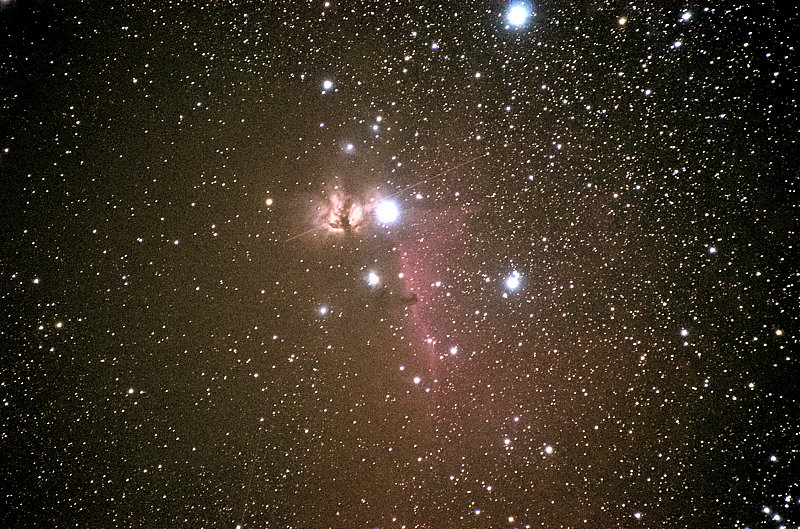Review - Gerd Neumann Bahtinov Mask for Camera Lens
Posted: 15 January 2015
 Bahtinov Mask for Camera Lens
Bahtinov Mask for Camera Lens
$59-$119
Gerd Neumann
I had been thinking about getting a Bahtinov Mask for my D7000 DSLR camera lens for several months. After having a lot of focusing challenges while doing some piggyback photography of Comet C/2014 Q2 (Lovejoy) on 3 January 2015, I finally decided to order a "Gerd Neumann Bahtinov Mask for Camera Lens" from OPT. My Nikon zoom lenses take 67mm filters, so that is the size Bahtinov Mask I ordered ($89). Sizes available are: 49mm, 52mm, 58mm, 67mm, 72mm, 77mm, and 82mm, ranging in price from $59 to $119.
Having used a Hartmann Mask and a Bahtinov Mask on my 8" telescope, I have been curious how well a mask would work on the smaller lens of a digital camera. Would there be enough light going through the mask from even brighter stars to allow seeing the diffraction spike pattern in the camera viewfinder or on the camera's "live view" screen? Or would it be necessary to take a long exposure image of the diffraction spike pattern to determine whether or not precise focus had been achieved? Read on to see how well the Gerd Neumann Bahtinov Mask performs.
Of course, the mask arrived during a period of cloudy nights. It came in a simple plastic bag, as seen above. Of course, the mask isn't much use during the daytime:

Here is the mask on my Nikon 70-300mm lens:

The mask, made of black coated aluminum, is laser cut with precise threads and cuts. I had no problem fitting it on my Nikon 18-105mm lens or Nikon 70-300mm lens. So, how does it perform when trying to focus a star?
On Wednesday, 14 January 2015, I finally had a clear night to test the Gerd Neumann Bahtinov Mask. I mounted my Nikon D7000 DSLR with 18-105mm lens piggyback on my 8" LX200-ACF and attached the Mask to the lens. I slewed to the star Sirius. I could see Sirius in the camera viewfinder using a focal length of 18mm, but the mask diffraction pattern was too faint to be seen. However, using Live View on the camera screen with ISO 25600 I could tell when the star was out of focus and when it was in focus. These iPhone photos of the Live View screen show what I saw, with the bright spots near center being the star Sirius:
Out of Focus

In Focus

When the star was in focus the star image was at its smallest. I could not see any diffraction pattern when in focus.
I slewed to the constellation of Orion and set the focal length to 34mm to have the entire constellation well-framed in the camera field-of-view (FOV). This is a f/4.2, 2 minutes, ISO 6400, FL 34mm, exposure of Orion with the stars nicely in focus:

The camera lens was then set to FL 105mm and the camera centered on the star Rigel. With the Bahtinov Mask on the lens the diffraction pattern was barely visible on the Live View screen at ISO 25600, but was not visible in the viewfinder. I returned to Orion and captured this well-focused image of Orion's belt and sword, f/5.6, 5 minutes, ISO 6400, FL 105mm:

The Flame Nebula and Horsehead Nebula are visible at the left, with the Great Orion Nebula at the bottom. A faint slow moving satellite is visible at the left.
I removed the 18-105mm lens from the camera and switched to the 70-300mm lens. With the focal length set to 300mm and using the star Rigel, it was very easy to see the diffraction pattern when in focus on the Live View screen at ISO 25600, and was just visible in the camera viewfinder. These 1 second, ISO 25600, photos show the diffraction patterns:
Out of Focus

In Focus

This f/5.6, 5 minutes, ISO 6400, FL 300mm, photo is well-focused and clearly shows the Flame and Horsehead nebulae, as well as a slow moving satellite passing infront of the Flame Nebula:

Summary
The Gerd Neumann Bahtinov Mask is of high quality and should last a long time with care. As long as the mask slots are not damaged, the mask should continue to perform well over time. It is very easy to use and will result in obtaining precise focus with a camera lens. If your camera has a high ISO setting available and a "live view" screen, you can easily achieve a precise focus. If your camera does not have a high enough ISO setting or does not have a live view, you can still get a good focus by taking photos as you adjust the focus ring on the lens. The longer focal length you use, the easier focusing will be. But you should still be able to achieve a good focus with almost any focal length lens.
The Gerd Neumann Bahtinov Mask is now a standard accessory in my DSLR photographic kit so that will always be available. If there is a model for your lens filter size, I recommend the Gerd Neumann Bahtinov Mask to help you get precisely focused astrophotographs with your camera.
Comments are welcome using Email. If you are on Twitter you can use the button below to tweet this report to your followers. Thanks.
Cassiopeia Observatory Home Page
Copyright ©2015 Michael L. Weasner / mweasner@me.com
URL = http://www.weasner.com/co/Reviews/2015/GN_Bahtinov_Mask/index.html

